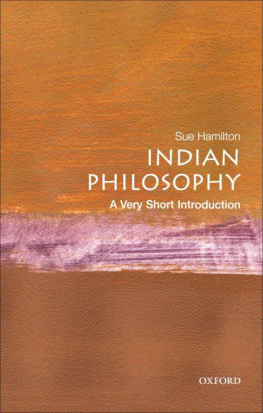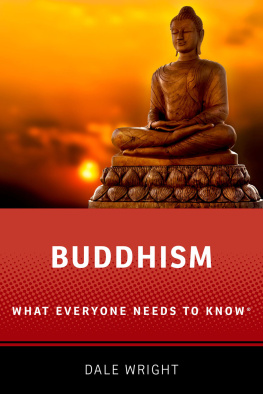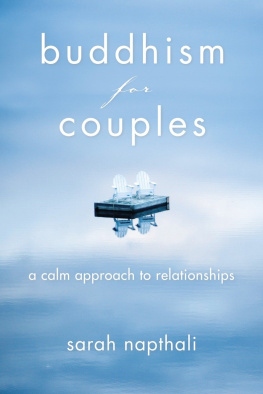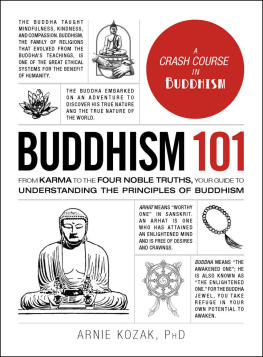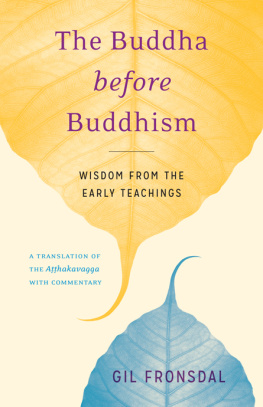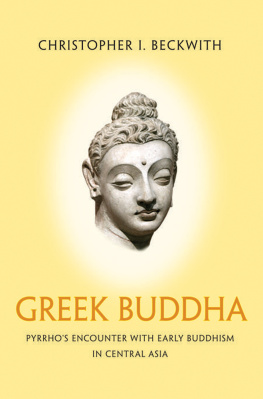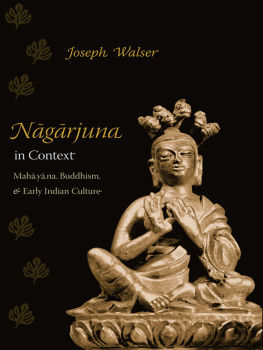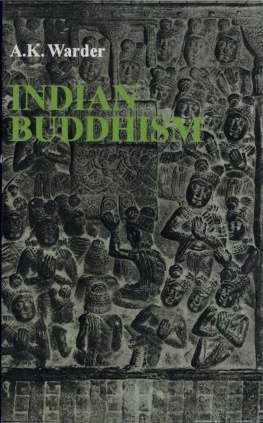
EARLY BUDDHISM: A NEW APPROACH
ROUTLEDGE CRITICAL STUDIES IN BUDDHISM
General Editors:
Charles S. Prebish and Damien Keown
The Routledge Critical Studies in Buddhism Series explores the complex and extensive Buddhist tradition from a variety of perspectives, using a range of different methodologies. The Series is diverse in its focus, including historical studies, textual translations and commentaries, sociological investigations, bibliographic studies, and considerations of religious practice as an expression of Buddhisms integral religiosity. It also presents materials on modern intellectual historical studies, including the role of Buddhist thought and scholarship in a contemporary, critical context and in the light of current social issues.
THE REFLEXIVE NATURE OF AWARENESS
Paul Williams
BUDDHISM AND HUMAN RIGHTS
Edited by Damien Keown, Charles Prebish, Wayne Husted
ALTRUISM AND REALITY
Paul Williams
WOMEN IN THE FOOTSTEPS OF THE BUDDHA
Kathryn R. Blackstone
THE RESONANCE OF EMPTINESS
Gay Watson
IMAGING WISDOM
Jacob N. Kinnard
AMERICAN BUDDHISM
Edited by Duncan Ryuken Williams and Christopher Queen
PAIN AND ITS ENDING
Carol S. Anderson
THE SOUND OF LIBERATING TRUTH
Edited by Sallie B. King and Paul O. Ingram
BUDDHIST THEOLOGY
Edited by Roger R. Jackson and John J. Makransky
EMPTINESS APPRAISED
David E Burton
THE GLORIOUS DEEDS OF PURNA
Joel Tatelman
CONTEMPORARY BUDDHIST ETHICS
Edited by Damien Keown
EARLY BUDDHISM: A NEW APPROACH
Sue Hamilton
EARLY BUDDHISM: A NEW APPROACH
The I of the Beholder
Sue Hamilton
First Published in 2000
by Routledge
2 Park Square, Milton Park, Abingdon, Oxon, OX14 4RN
270 Madison Ave, New York NY 10016
Transferred to Digital Printing 2008
2000 Sue Hamilton
Typeset in Sabon by LaserScript Ltd, Mitcham, Surrey
All rights reserved. No part of this book may be reprinted or reproduced or utilised in any form or by any electronic, mechanical, or other means, now known or hereafter invented, including photocopying and recording, or in any information storage or retrieval system, without permission in writing from the publishers.
British Library Cataloguing in Publication Data
A catalogue record of this book is available from the British Library
Library of Congress Cataloguing in Publication Data
A catalogue record for this book has been requested
ISBN 0700712801 (Hbk)
ISBN 0700713573 (Pbk)
Publishers Note
The publisher has gone to great lengths to ensure the quality of this reprint but points out that some imperfections in the original may be apparent
To Richard and Catherine, with love
Contents
I am grateful to the many people, family, friends, colleagues and students, who have contributed, directly and indirectly, to the completion of this book.
More particularly, my profound thanks are extended to Muriel Anderson, Bryan Appleyard, Tyrrell Burgess, Damien Keown and Anthony Storr for their comments on various draft stages of the book. Their generosity in giving up their time to offer invaluable constructive criticism is greatly appreciated. I accept full responsibility for the final version.
To Richard and Catherine Sarson, whose support was at times a sine qua non, thanks always.
AN | Aguttara Nikya |
B. Up. | Bhadrayaka Upaniad |
Ch. Up. | Chndogya Upaniad |
DA | Dgha Nikya Ahakath |
DN | Dgha Nikya |
J | Jtaka |
MN | Majjhima Nikya |
PED | Pali-English Dictionary, PTS edition |
PTS | Pali Text Society |
V | g Veda |
at. Br. | atapatha Brhmaa |
SN | Sayutta Nikya |
Thag. | Theragth |
Vin | Vinaya |
Sources, Methods and Caveats
This book is an attempt to draw out the ideas about and understanding of human experience in early Buddhism. With particular reference to central doctrinal teachings relating to the issue and nature of selfhood, continuity, and the operating of subjective cognitive processes, it seeks to present such teachings as coherent in themselves and as collectively contributing to a coherent overall picture of the early Buddhist view of the experiential world in its entirety. I also hope to show that apparent anomalies, inconsistencies and, indeed, incoherencies in previous scholarly and traditional interpretations of certain key issues such as the anatt, not-self, doctrine are unnecessary, and that a close reading of the relevant texts suggests that an alternative interpretation is both more appropriate and more informative in the context of the teachings as a whole.
I am drawing primarily on a group of texts known as the Nikyas of the Pali canon. The Pali canon is comprised of a large collection of texts, written in Pali, belonging to the Theravda school of Buddhism. The canon has three sections (called piakas baskets), and the Nikyas comprise most of what is called the Sutta Piaka, the section on doctrinal teachings. So when I use the expression early Buddhism, it is to what is contained in the Pali Sutta Piaka that I am referring. These texts are only one of the sources of early Buddhism known to us. Other sources, in languages other than Pali (notably Sanskrit and Chinese), and belonging to schools of Buddhism other than Theravda, also represent a very early period in the history of Buddhism. In using the term early Buddhism about what is to be found in the Nikyas, I am not seeking to imply that the Theravda sources are the earliest, or that what they say is more truly representative of early Buddhist teachings. Nor am I seeking to establish an identifiable period in the history of Buddhism that might universally be labelled the early period.1 I am, rather, using it for simplicity of expression to refer to what is to be found in some of the early texts.
In focussing on this specific collection of texts, I am not seeking to make claims about the teachings, textual interpretations, beliefs or practices of Theravda Buddhism as a whole. Such an exercise would require one to consult a far wider corpus of canonical, commentarial and other Theravda textual material than just the Nikyas.2 Theravda Buddhism is a living tradition that has grown and spread from its beginnings in the Indian sub-continent over a period of nearly two and a half millennia. It would be extraordinary if one relatively small section of its texts precisely represented all of its understanding of Buddhist teachings. It would also be unlikely that such a thing as the Theravda view would be arrived at. Because it has grown and become as diversified as it has, it would be surprising if different Theravda communities within the tradition did not emphasise or concentrate on different parts of their textual corpus, ranging as it does from monastic disciplinary rules to story literature, doctrinal treatises to technical scholarly definitions,


